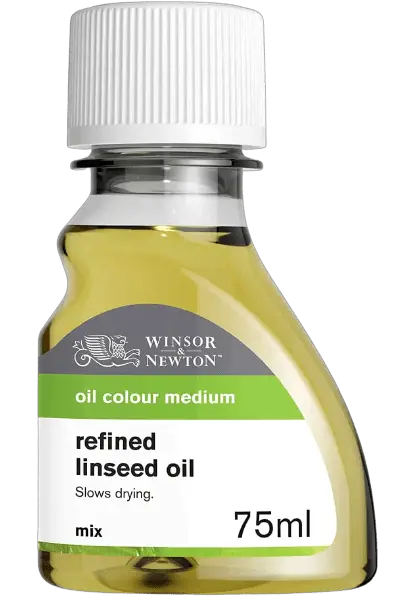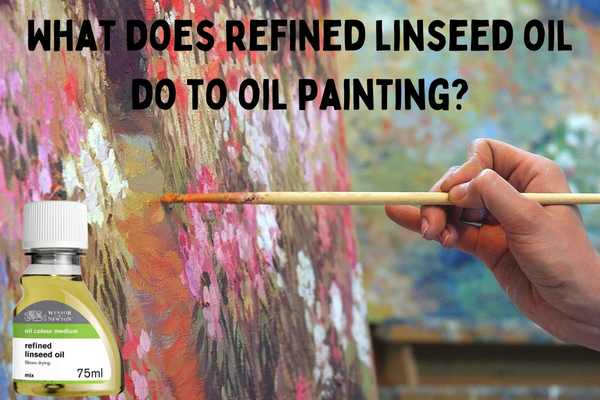We all know that drying oils are essential for oil painting but when it comes to quality, refined linseed oil is the most preferred medium by professional artists.
But what is actually a refined linseed oil, and which characteristics make it more expensive and better than raw linseed oil?
Table of Contents
- What does refined linseed oil do to oil paint?
- What are the benefits of refined linseed oil?
- What are the disadvantages of refined linseed oil?
- How much-refined linseed oil to add to oil paint?
- Can you use refined linseed oil for oiling out?
- Is refined linseed oil flammable?
- Difference between raw and refined linseed oil
- purified vs refined linseed oil
- Does refined linseed oil yellow
- Final Words
- FAQs
Well, refined linseed oil is a common medium that artists usually use to increase the consistency and flow of their oil paints. It not just increases consistency but also makes the oil paint more durable, allowing it to cure more evenly on the surface.
This refined linseed oil is yellowish in color with a mild and fatty smell which is very similar to raw linseed oil.
What does refined linseed oil do to oil paint?
When refined linseed oil mix with oil paint, it gives a glossy, transparent, and balanced satin finish to the whole oil painting surface when used in a balanced amount. It can also be used for thinning the paint to make it more fluid. It also doesn’t get yellow over time like raw linseed oil.

Refined linseed oil is made by collecting oil from flaxseed plants and then it is filtered by various types to remove any excessive impurities. Then this oil is distilled by vacuum distillation and the resulting oil is lighter which is suitable to use in oil painting.
The price of refined linseed oil is comparatively higher than raw linseed oil just because of additional processes making it more suitable for oil painting.
What are the benefits of refined linseed oil?

Refined linseed oil is a powerful medium for oil painting and it has several advantages such as an increase in durability, handling, and clarity, and it does not cause oil paints to get yellow.
If you are really serious about the effect of refined linseed on your oil paintings, check the following description about the advantages:
- Improved Handling: Refined linseed oil makes the oil paint more fluid which makes it comfortable to paint the surface while using a brush. You can easily grip your brush because you don’t have to apply a lot of pressure because of the fluidity.
- No yellowing: Some artists prefer the natural yellowish of oil paints but this oil is outstanding for those who don’t want their paintings to get yellow over time.
- Moderate drying time: It has a moderate drying time which means will not dry very fast or not very slowly. It has a faster drying time as compared to raw linseed oil but other oils such as cold-pressed linseed oil have a faster drying time than refined linseed oil.
- Increase in durability: Durability is the most important thing for masterpieces and that is a common reason why professionals prefer it the most.
What are the disadvantages of refined linseed oil?
Compared to raw linseed oil, it has only one disadvantage which is the price range. It is not beginners friendly due to price comparison. A 250ml bottle of refined linseed oil is gonna cost you 25.47$ but you can get linseed oil for just 22.29$ in the same quantity.
However, refined linseed oil does not yellow like raw linseed oil but if you overuse it, it can cause not just yellowing but also cracking over time.
How much-refined linseed oil to add to oil paint?
You can use it in the same quantity as you use normal linseed oil. It means 1-2 drops are enough to use for one time.
Remember that the “Fat over Lean” principle is applicable to all oil paintings. By following it, you have to use a little amount of oil for starting layers but as you move to the final layers, slowly increase the amount of oil. Suppose you have used 1 drop in previous layers, you can increase the quantity to 2 for the final layers.
Can you use refined linseed oil for oiling out?
Well, it is the same as raw linseed oil but you can say it is better. If you can use linseed oil for oiling out then why not refined linseed oil? Yes, you can use refined linseed oil as well for oiling out.
Is refined linseed oil flammable?
Yes, like other types of linseed oil, refined linseed oil is also flammable that can ignite if you use it in a fire or around the fire.
You have to keep in mind that you don’t do oil painting near a sire source. It will not just cause a fire in refined linseed oil but also other solvents which are more dangerous to handle also ignite.
Also, make sure that you don’t do oil painting directly under sunlight in summer which can ruin the original glow of your oil paints.
Difference between raw and refined linseed oil
Making linseed oil is a natural procedure in which oil is extracted from flaxseed plants and then it is filtered out but refined linseed oil bare so many processes of filtration and distillation. That’s why it is a little bit lighter than linseed oil.
The difference between raw and refined linseed oil in oil painting is given below in the table.
| Refined Linseed Oil | Raw Linseed oil | |
| Price | 8.49 USD per 75ml (Wonsor&Newton) | 7.50 USD per 75ml (Wonsor&Newton) |
| Yellowish | Less yellow over time | More yellow over time |
| Flow | Better flow | Less flow |
| Consistency | More consistency with oil paints | Less consistency with oil paints |
| Texture | Balanced textures | Not balanced |
| Beginner’s extent | Not beginner’s friendly | Beginner’s friendly |
purified vs refined linseed oil
I got a question about purified and refined linseed oil. Well, both of these oils are the same because refined linseed oil undergoes the same process of purification. The qualities and work potential of both oils are the same as oil paints.
Does refined linseed oil yellow
If you use refined linseed oil in a moderate quantity then it will not cause yellow over time but if you use a higher amount to make the paint film thicker then it will dry slowly and cause yellow over time.
Overuse of refined linseed oil can also cause a cracking effect in oil paints.
Final Words
Refined linseed oil is just a perfect choice for those who know the proper use of it. For beginners, this blog information will help increase their knowledge about oil painting.
However, refined linseed oil is just a few dollars more expensive than raw linseed oil but its results are worth the money. I am pretty sure that you will be able to differentiate the outputs of refined and raw oil after use. But at last, I will wind up just by saying that any drying oil can be a good choice for oil painting. But an artist can create wonderful results with any oil of his choice.
FAQs
Can I add sans-odor refined linseed oil for oil paintings?
Yes, you can do so but the thing is that refined linseed oil will become gel and you will not be able to store it for a long time. However, it will work for oil paintings.
Which oil is better for wetting and dispersion of dry pigment, raw linseed or refined linseed oil?
For wetting and dispersion, there are some other great choices such as cold-pressed linseed oil and stand oil. But both raw and refined linseed oil is not that much better for wetting and desperation.
